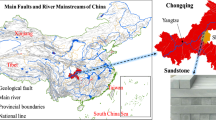Abstract
Simulated annealing (SA) has the capacity to handle complex problem of fracture heterogeneity. However, its applications to characterization and modeling of an actual discrete fracture network are limited. Borrowing the context of geothermal reservoirs (where extensive discrete fractures exist), this paper attempts to solve several key practical issues that persist in current models: objective function’s (OF’s) formulation, modification scheme, and stop criteria. The improvements are examined in a case study on an actual fracture outcrop, where results are compared with a current and advanced SA work.
Similar content being viewed by others
Reference
Belfield, W.C.: Incorporating spatial distribution into stochastic modelling of fractures: multifractals and Levy-stable statistics. J. Struct. Geol. 20, 473–486 (1998)
Cacas, M.C., Ledoux, E., Demarsily, G., Tillie, B., Barbreau, A., Durand, E., Feuga, B., Peaudecerf, P.: Modeling fracture flow with a stochastic discrete fracture network—calibration and validation. 1. The flow model. Water Resour. Res. 26, 479–489 (1990)
Day-Lewis, F.D., Hsieh, P.A., Gorelick, S.M.: Identifying fracture-zone geometry using simulated annealing and hydraulic-connection data. Water Resour. Res. 36, 1707–1721 (2000)
Deutsch, C.V., Cockerham, P.W.: Practical considerations in the application of simulated annealing to stochastic simulation. Math. Geol. 26, 67–82 (1994)
Eglese, R.W.: Simulated annealing: a tool for operational research. Eur. J. Oper. Res. 46, 271–281 (1990)
Farmer, C.L.: Numerical rocks. In: King, P.R. (ed.): The Mathematics of Oil Recovery, p. 817. Clarendon Press—Oxford University Press, Oxford [England]—New York xviii (1992)
Gauthier, B.D.M., Garcia, M., Daniel, J.M.: Integrated fractured reservoir characterization: a case study in a North Africa field. SPE Reserv. Evalu. Eng. 5, 284–294 (2002)
Geman, S., Geman, D.: Stochastic relaxation, Gibbs distributions, and the Bayesian restoration of images. IEEE Trans. Pattern Anal. Mach. Intell. 6, 721–741 (1984)
Gringarten, E.: 3-D geometric description of fractured reservoirs. Math. Geol. 28, 881–893 (1996)
Guerreiro, L., Silva, A.C., Alcobia, V., Soares, A.: Integrated Reservoir Characterisation of a Fractured Carbonate Reservoir. SPE58995, Society of Petroleum Engineers International Petroleum Conference and Exhibition (2000)
Kirkpatrick, S., Gelatt, C.D., Vecchi, M.P.: Optimization by simulated annealing. Science 220, 671–680 (1983)
Long, J.C.S., Karasaki, K., Davey, A., Peterson, J., Landsfeld, M., Kemeny, J., Martel, S.: An inverse approach to the construction of fracture hydrology models conditioned by geophysical-data—an example from the validation exercises at the Stripa Mine. Int. J. Rock Mech. Min. Sci. Geomech. Abstr. 28, 121–142 (1991)
Mauldon, A.D., Karasaki, K., Martel, S.J., Long, J.C.S., Landsfeld, M., Mensch, A., Vomvoris, S.: An inverse technique for developing models for fluid-flow in fracture systems using simulated annealing. Water Resour. Res. 29, 3775–3789 (1993)
Metropolis, N., Rosenbluth, A.W., Rosenbluth, M.N., Teller, A.H., Teller, E.: Equation of state calculations by fast computing machines. J. Chem. Phys. 21, 1087–1092 (1953)
Nakao, S., Najita, J., Karasaki, K.: Hydraulic well testing inversion for modeling fluid flow in fractured rocks using simulated annealing: a case study at Raymond field site, California. J. Appl. Geophys. 45, 203–223 (2000)
Ouenes, A.: Practical application of fuzzy logic and neural networks to fractured reservoir characterization. Comput. Geosci. 26, 953–962 (2000)
Ouenes, A., Bhagavan, S., Bunge, P.H., Travis, B.J.: Application of simulated annealing and other global optimization methods to reservoir description: myths and realities. Society of Petroleum Engineers 69th annual technical conference and exhibition (1994)
Rahman, M.K., Hossain, M.M., Rahman, S.S.: An analytical method for mixed-mode propagation of pressurized fractures in remotely compressed rocks. Int. J. Fract. 103, 243–258 (2000)
Rawnsley, K., Wei, L.: Evaluation of new method to build geological models of fractured reservoirs calibrated to production data. Pet. Geosci. 7, 23–33 (2001)
Sahimi, M.: New Models for Natural and Hydraulic Fracturing of Heterogeneous Rock. SPE29648, Society of Petroleum Engineers Western Regional Meeting (1995)
Sen, M.K., Stoffa, P.L.: Global optimization methods in geophysical inversion. Elsevier, Amsterdam; New York (1995)
Soares, A., Brusco, A., Guimaraes, C.: Simulation of naturally fractured fields. Geostatistics Wollongong 1433–1441 (1996)
Tran, N.H., Chen, Z., Rahman, S.S.: Characterizing and modelling of fractured reservoirs with object-oriented global optimization. J. Can. Pet. Technol. 46, 1–7 (2007)
Tran, N.H., Chen, Z.X., Rahman, S.S.: Integrated conditional global optimisation for discrete fracture network modelling. Comput. Geosci. 32, 17–27 (2006)
Tran, N.H., Rahman, S.S.: Modelling discrete fracture networks using neuro-fractal-stochastic simulation. J. Eng. Appl. Sci. 1, 154–160 (2006)
Tran, N.H., Tran, K.: Combination of fuzzy ranking and simulated annealing to improve discrete fracture inversion. Math. Comput. Model. 45, 1010–1020 (2007)
Vanlaarhoven, P.J.M., Aarts, E.H.L., Lenstra, J.K.: Job shop scheduling by simulated annealing. Oper. Res. 40, 113–125 (1992)
Xie, H.P., Wang, J.A., Kwasniewski, M.A.: Multifractal characterization of rock fracture surfaces. Int. J. Rock Mech. Min. 36, 19–27 (1999)
Author information
Authors and Affiliations
Corresponding author
Rights and permissions
About this article
Cite this article
Tran, N.H. Simulated annealing technique in discrete fracture network inversion: optimizing the optimization. Comput Geosci 11, 249–260 (2007). https://doi.org/10.1007/s10596-007-9049-7
Received:
Accepted:
Published:
Issue Date:
DOI: https://doi.org/10.1007/s10596-007-9049-7




